I had a picture this week of another new calf. Today I was able to get some closer shots.
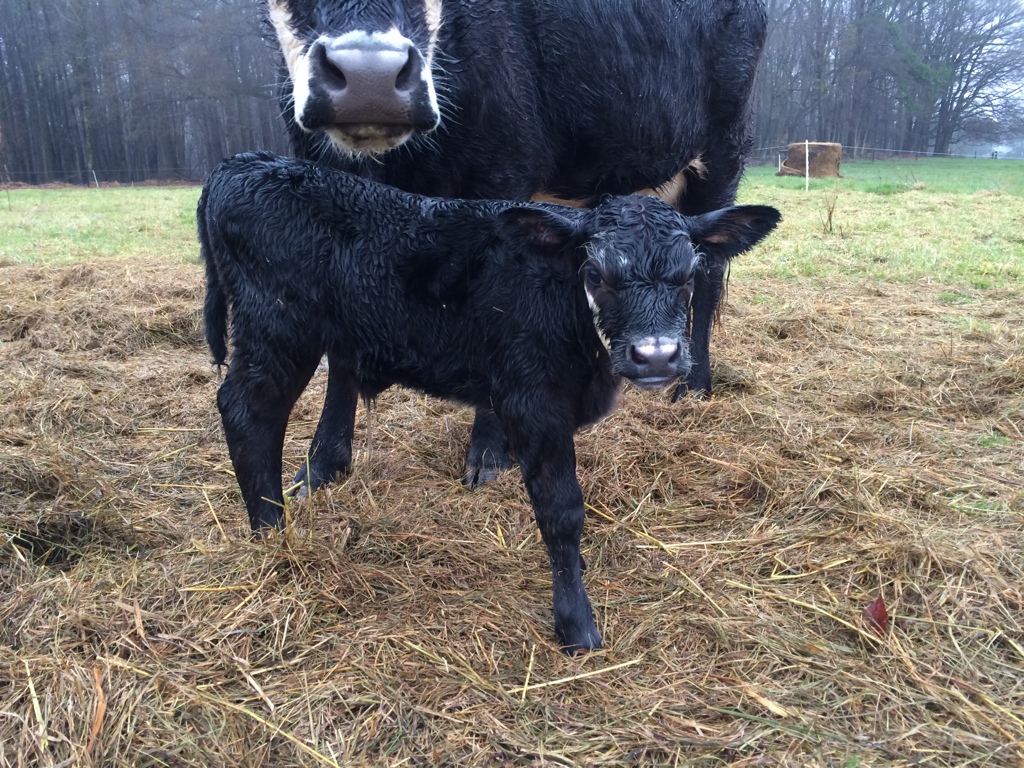
Yesterday our new calf got her earring and her name. #33 was the tag and Birdie is her name. She’s a cutie with white whiskers and white sort of eyelashes.
7125 Old Stage Road Raleigh NC 919-322-0197
I had a picture this week of another new calf. Today I was able to get some closer shots.

Yesterday our new calf got her earring and her name. #33 was the tag and Birdie is her name. She’s a cutie with white whiskers and white sort of eyelashes.
As if daily pictures of the hog class isn’t enough, I’m going to be posting some more pictures in a series before too long. This one is of a farm truck that’s had quite a transformation. Last year I was asked by someone very special to me if she could use my old 1972 farm truck in her wedding. She said I didn’t need to do anything for the wedding, except maybe wash the dust off. Well that wasn’t good enough for her if I had anything to do with it so I decided that I would restore the truck to as good of condition as I could time and money permitting. Here is what the truck looked like before we did anything to it.
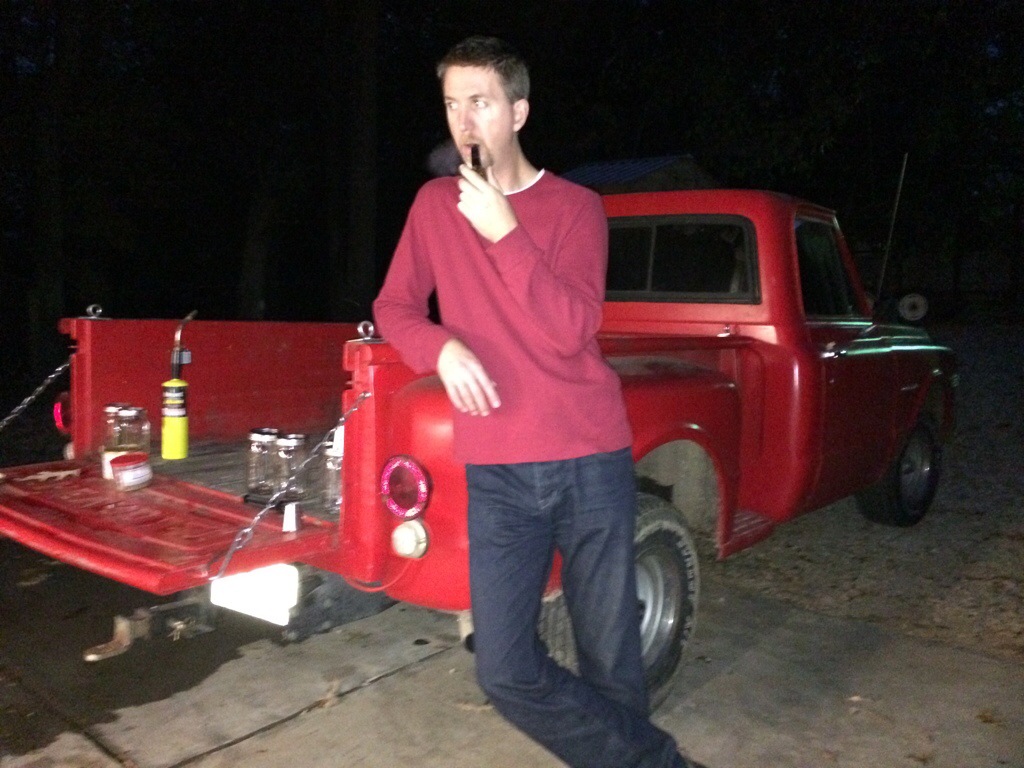 That’s not red paint, it’s red primer. The truck was pretty much sound as I’d already gone through the running gear. Most of the chrome was pitted and dull. The body needed work in various places, the bed wood was rotten, there was no rear bumper, etc, etc. Nice old truck, but it need of a lot of work.
That’s not red paint, it’s red primer. The truck was pretty much sound as I’d already gone through the running gear. Most of the chrome was pitted and dull. The body needed work in various places, the bed wood was rotten, there was no rear bumper, etc, etc. Nice old truck, but it need of a lot of work.
Saturday the 15th, after 3 months of work, I had the privilege of being a small part of a beautiful wedding in Pinehurst. The end product looked like this.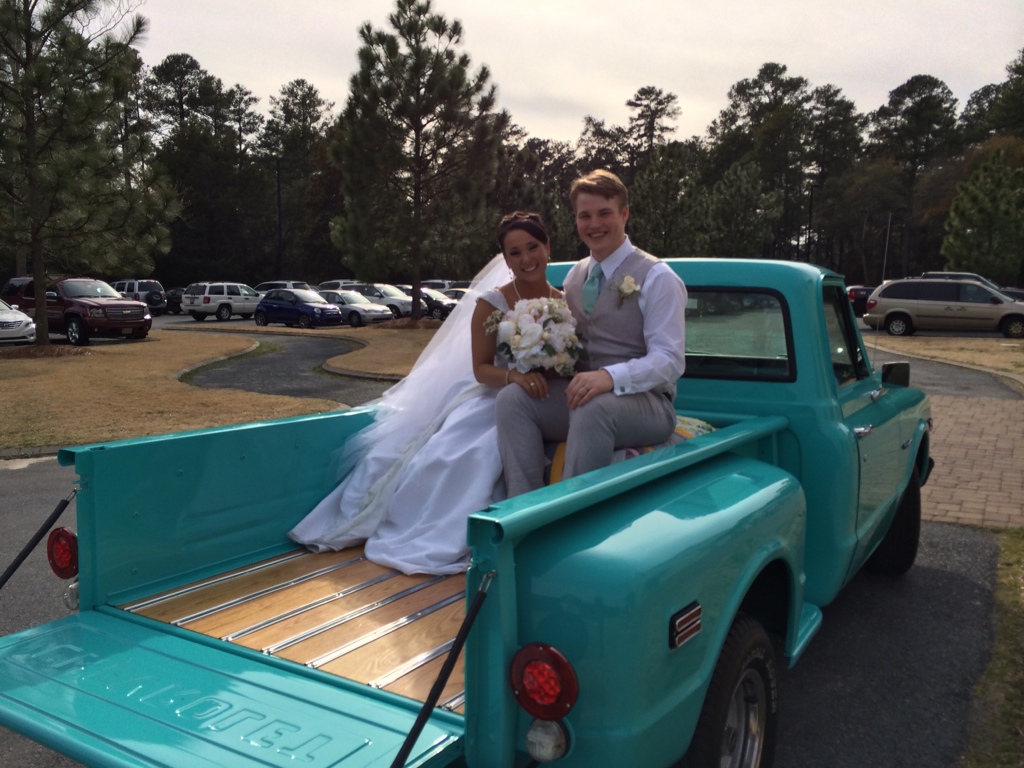
Since this is our old farm truck, now fully restored, I thought I’d post the transformation pictures here for posterity. The pictures don’t really do the transformation justice as the red looks pretty good in the picture and the teal doesn’t look nearly as good in real life. It’s a stunning transformation and I’m very pleased with the results. Now the only problem is my old farm truck is too nice to be a farm truck anymore!
We’ve had some requests from some of SWMBOs friends for me to teach some canning classes. We have not set a date yet on the classes but due to her requests and the fact that she’s filling the class before I even have it scheduled I’m letting all of you know I’m going to host some canning classes this year. The first will be a water bath canning class taught late spring. The second, held sometime mid-summer, will be a pressure canning class.
In the water bath canning class, we’ll learn the easiest method of canning, boiling water canning. This is the one that you can do when you get home and handles 90% of what you’ll can in the future. We’ll likely can some green beans and maybe make some pickles. It depends on what is coming in from the garden and the market at that time. Lesson one of canning, you can learn it here and now, is it depends on natures bounty what you’re canning. There won’t be any store bought produce going into our canning. Everyone will go home with something that you’ve canned yourself. The cost will be $20 per person and since this will be mostly people that we know, there will be wine consumed so you’ve been warned.
For the pressure canning class, we’ll step it up a notch so think of this as canning 201. Pressure canning is used mainly for canning something with meat in it. It requires a higher temperature and specialized equipment. Likely we’ll have the same folks back and similar environment however this time we’ll be making tomato sauce with meat, hopefully beef if we have a cow in the freezer by then. Each summer we make dozens of jars of our own sauce and this is more of a scheduled production because it’s our main garden product each year. Basically once the tomatoes start coming in, we’ll be ready to can. Tomato sauce is something used in our kitchen once or twice a week all year. No sense buying Prego when you can have home cooked easily enough. The cost of this class will be $20 as well and you’ll get a jar of sauce to take home.
Like our hog class, we are not expert canners. This is an experience class for anybody wanting to learn how to can and have the chance to participate with someone who’s already doing it and learn the ropes. When you leave, you’ll have the experience to can your own product. In each class we will wash, chop, and prep all the veggies. We will clean the jars, fill, seal, and can. We’ll discuss our storage options (canning, dehydrating, freezing, etc), what resources I reference for my canning questions, what’s possible with canning and what’s not, how to tell if the canning worked, how to tell if something has gone bad and should be tossed, and as always answer any questions you may have.
These classes will be limited to 10 people but if there is enough interest we can teach multiple classes since we can all summer.
If you are interested in taking a canning class, contact me at dan@ninjacowfarm.com and I’ll make sure you get an invite when we schedule the classes.
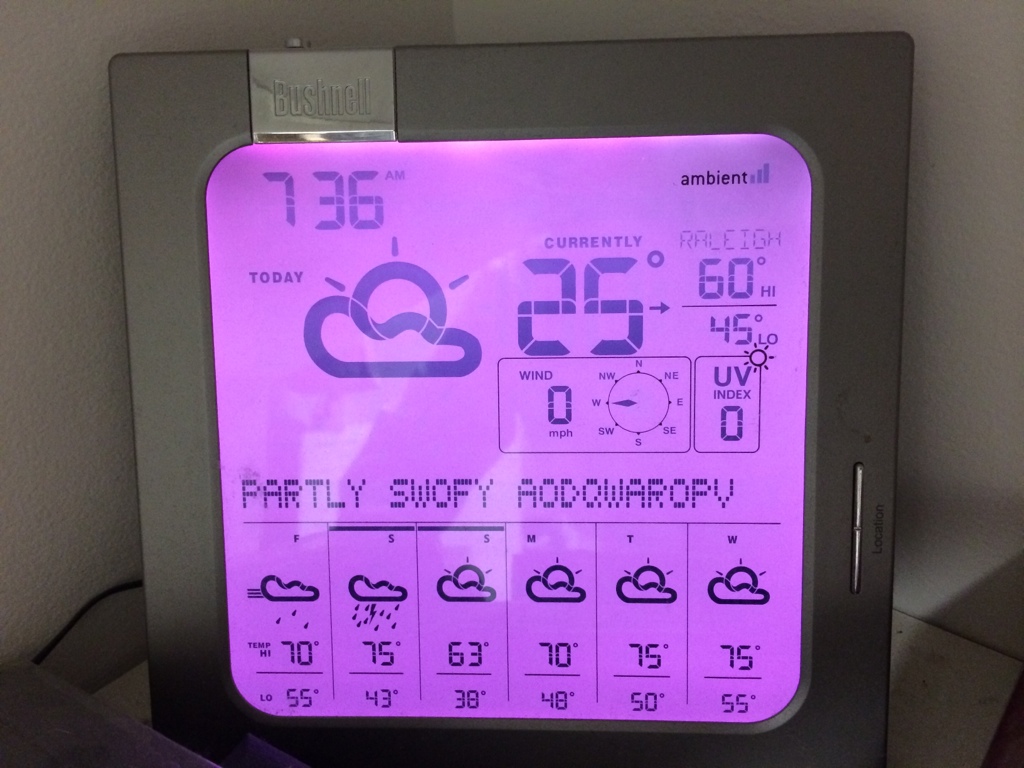
I have in my closet an automatic weather station which does a fantastic job of giving me the days and the weeks weather at a glance. For today, there is a description of the conditions as well. Things like “windy and cooler” or “sunny and beautiful.”
I’m not really sure what “swofy” is, but after the winter we’ve had I’m looking forward to it!
>
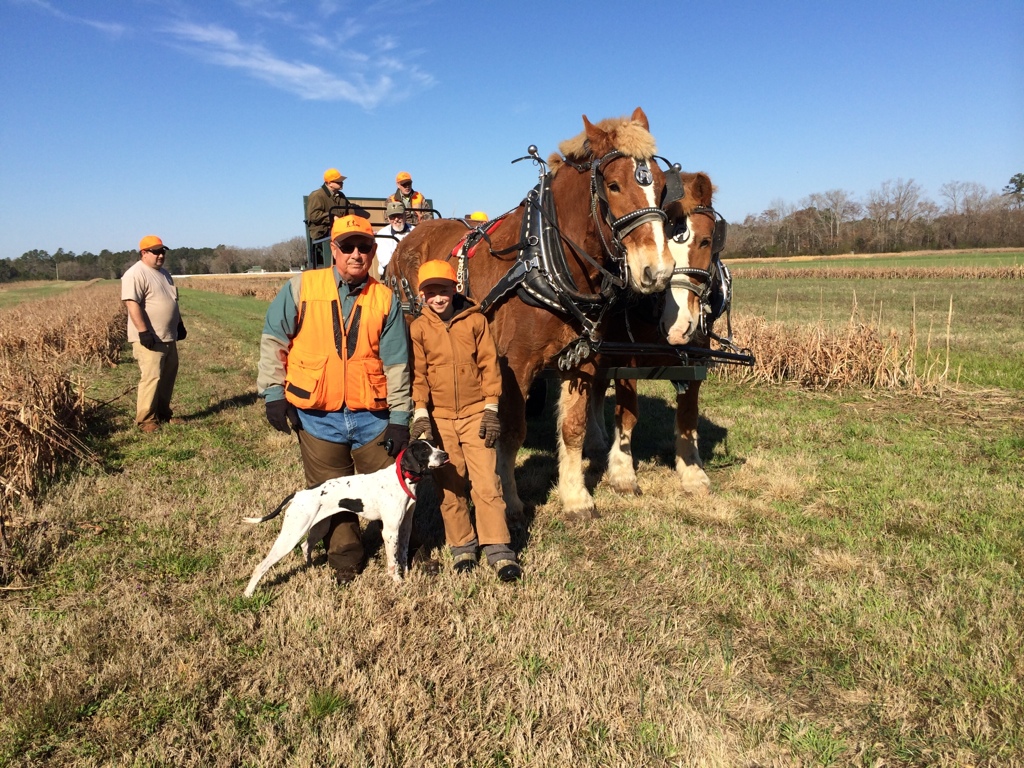
Spork and I had the chance of a lifetime recently. We were invited by a new friend to go and hunt on a private quail hunt. I knew it would be nice but I had no idea how nice. We traveled the farm in a custom built horse drawn hunting wagon handled by a competition draft team and expert driver. We hopped off occasionally to hunt behind champion bird dogs and their owner. The weather was 72 degrees and the sun was gorgeous after a nasty cold winter.
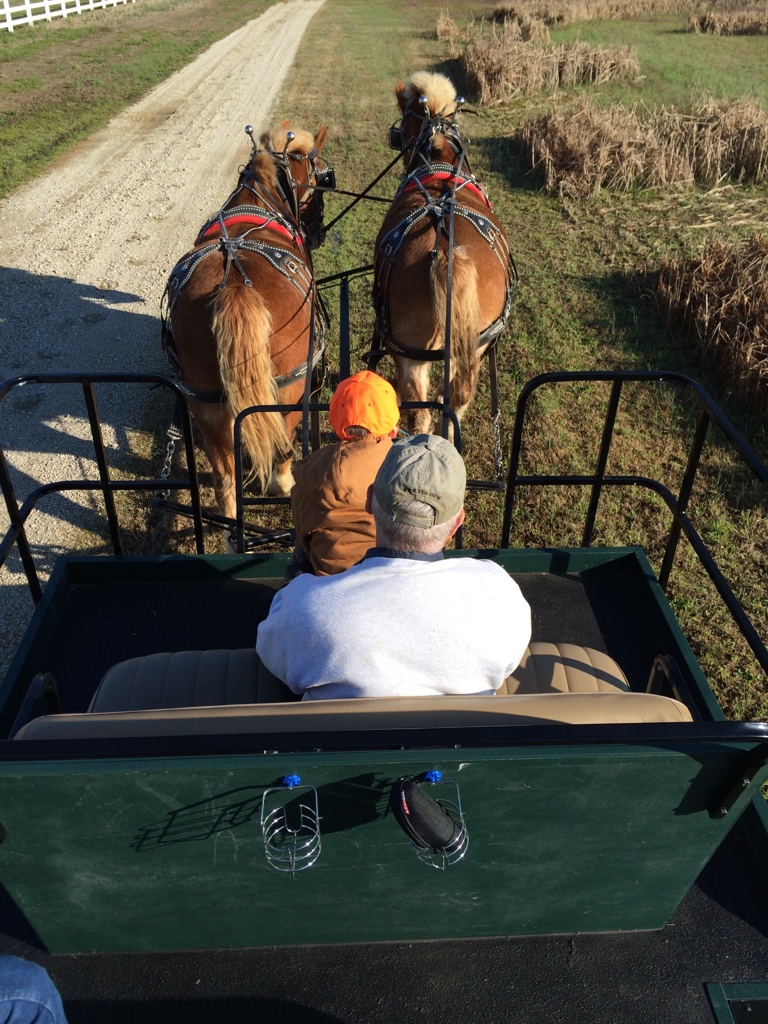
Here is Spork helping drive the team. After hunting half the day, we retired to a beautifully restored 1800s era farm house where we had a 3 course home cooked meal on fine china.
We were terribly lucky to be invited to share this experience. I’ve paid a lot of money to go on hunts that weren’t 1/10th as nice. I’m so thankful that I was able to share it with my son.
I learned that there is a draft horse competition on April 12th in the same area. I’m hoping to get more information on this event and take all the kids to it. I think they will have a good time. Dagny still wants to know when she can compete in the tractor pull. >
I wasn’t even aware that farm buildings could be regulated for building codes. When we’ve built buildings in the past we used to get a farm permit which was basically a permit that said we didn’t need a permit. Since I had stopped asking some time ago if I could get a permit, I guess I missed the part where they started regulating farm buildings. Oops. I know our smoke house isn’t up to code. Of course, in a hurricane I believe its the safest place on the farm unless I can figure out how to get inside a gun safe. Anyway, looks like none of that matters because according to section 5 of the law below, our farm buildings are not held to the building codes which suits me just fine. Since we use pretty much everything for our old time hog killings, I’d say we qualify.
SESSION LAW 2013-75
HOUSE BILL 774
AN ACT TO EXEMPT CERTAIN PRIMITIVE STRUCTURES FROM THE BUILDING CODE.
The General Assembly of North Carolina enacts:
SECTION 1. G.S. 143-138 reads as rewritten: Ҥ 143-138. North Carolina State Building Code.
…
(b3) Except as provided by subsection (c1)subsections (b4) and (c1) of this section, the Code may contain provisions regulating every type of building or structure, wherever it might be situated in the State.
(b4) Building rules do not apply to (i) farm buildings that are located outside the building-rules jurisdiction of any municipality, or (ii)(ii) farm buildings that are located inside the building-rules jurisdiction of any municipality if the farm buildings are greenhouses.greenhouses, (iii) a primitive camp, or (iv) a primitive farm building. For the purposes of this subsection:
(1) A “farm building” shall include any structure used or associated with equine activities, including, but not limited to, the care, management, boarding, or training of horses and the instruction and training of riders. Structures that are associated with equine activities include, but are not limited to, free standing or attached sheds, barns, or other structures that are utilized to store any equipment, tools, commodities, or other items that are maintained or used in conjunction with equine activities. The specific types of equine activities, structures, and uses set forth in this subdivision are for illustrative purposes, and should not be construed to limit, in any manner, the types of activities, structures, or uses that may be considered under this subsection as exempted from building rules. A farm building that might otherwise qualify for exemption from building rules shall remain subject only to an annual safety inspection by the applicable city or county building inspection department of any grandstand, bleachers, or other spectator-seating structures in the farm building. An annual safety inspection shall include an evaluation of the overall safety of spectator-seating structures as well as ensuring the spectator-seating structure’s compliance with any building codes related to the construction of spectator-seating structures in effect at the time of the construction of the spectator-seating.
(2) A “greenhouse” is a structure that has a glass or plastic roof, has one or more glass or plastic walls, has an area over ninety-five percent (95%) of which is used to grow or cultivate plants, is built in accordance with the National Greenhouse Manufacturers Association Structural Design manual, and is not used for retail sales. Additional provisions addressing distinct life safety hazards shall be approved by the local building-rules jurisdiction.
(3) A “farm building” shall include any structure used for the display and sale of produce, no more than 1,000 square feet in size, open to the public for no more than 180 days per year, and certified by the Department of Agriculture and Consumer Services as a Certified Roadside Farm Market.
(4) A “primitive camp” shall include any structure primarily used or associated with outdoor camping activities, including structures used for educational, instructional, or recreational purposes for campers and for management training, that are (i) not greater than 4,000 square feet in size and (ii) are not intended to be occupied for more than 24 hours consecutively. “Structures primarily used or associated with outdoor camping activities” include, but are not limited to, shelters, tree stands, outhouses, sheds, rustic cabins, campfire shelters, picnic shelters, tents, tepees or other indigenous huts, support buildings used only for administrative functions and not for activities involving campers or program participants, and any other structures that are utilized to store any equipment, tools, commodities, or other items that are maintained or used in conjunction with outdoor camping activities such as hiking, fishing, hunting, or nature appreciation, regardless of material used for construction. The specific types of primitive camping activities, structures, and uses set forth in this subdivision are for illustrative purposes and should not be construed to limit, in any manner, the types of activities, structures, or uses that are exempted from building rules.
(5) A “primitive farm building” shall include any structure used for activities, instruction, training, or reenactment of traditional or heritage farming practices. “Primitive farm buildings” include, but are not limited to, sheds, barns, outhouses, doghouses, or other structures that are utilized to store any equipment, tools, commodities, livestock, or other items supporting farm management. These specific types of farming activities, structures, and uses set forth by this subdivision are for illustrative purposes and should not be construed to limit in any manner the types of activities, structures, or uses that are exempted from building rules.
….”
SECTION 2. This act is effective when it becomes law.
In the General Assembly read three times and ratified this the 6th day of June, 2013.
s/ Daniel J. Forest President of the Senate
s/ Thom Tillis
Speaker of the House of Representatives
s/ Pat McCrory
Governor
Approved 4:19 p.m. this 12th day of June, 2013
Page 2 Session Law 2013-75 House Bill 774
Dottie, our milk cow, was supposed to be dried off and beginning to eat for herself. Of course she went out and adopted a greedy bull calf who is too large to be nursing anyway. So we put her in isolation where she could dry off. Unfortunately cows are herd animals and she was none too pleased to be in a pasture by herself so I put a friend in there with her, #9 a young heifer. Dottie then calmed down and commenced to eating for all she was worth. Problem solved.
Then Friday I discover this.
Yep, I needed #9 to hang out one week while Dottie dried off so she took the opportunity to give us a cute little heifer calf instead. Now I am watching Dottie to make sure she doesn’t adopt this one too.

This is a few hours after this calf was born. She was still wet.
This is on Sunday when I checked on her. This is another calf off of Benjamin so this one is a keeper. That means she needs a name. Any thoughts?
>
I’ve mentioned before that we received some grants from Wake County Soil and Water and from NRCS. I’ve never really explained what and why that’s about. Now I don’t have to, since Darby did such a good job over at the Brink of Freedom website. There’s a bit of tinfoil hattery for a paragraph in the middle but the rest is a good write up of NRCS and EQUIP. My experience is equally as positive.